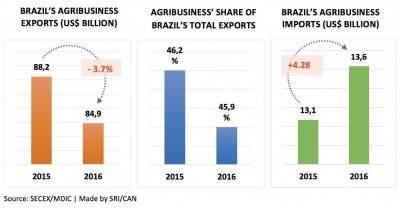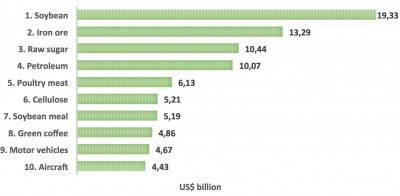Agribusiness 46% of Brazil’s exports in 2016
From: Agro Brazil Bulletin, 4th edition, June 2017 *
Recently, Brazil began a process of economic stabilization in the face of the strong recession that began in 2014. The agricultural sector was not immune to the effects of this crisis. However, the sector has shown strength. Brazilian farmers continue to do their homework, investing in technology and meeting high quality and sustainability standards. For this reason, even in a period of economic and political difficulties, Brazil emerges as an agricultural powerhouse and a major responsible for feeding the world population.

An Agricultural Outlook
Agriculture is the most vibrant sector of the Brazilian economy, making a significant contribution to the country’s trade balance. In 2016, its products represented 45.9% of Brazil’s total exports. Agricultural exports amounted to US$ 84.9 billion, a 3.7% drop when compared to the US$ 88.2 billion sold the year before. Imports reached US$ 13.6 billion. That way, Brazil’s agribusiness enjoyed a trade surplus of US$ 71.3 billion. Despite the positive balance, Brazil’s overall trade flow has decreased 11% when compared to 2015.
From January to April 2017, however, Brazil already sold US$ 29.19 billion in agricultural products to the world, a 3.8% increase from the US$ 28.11 billion exported in the same period of 2016. Imports grew by 21%, going from US$ 4.0 billion in 2016 to US$ 4.84 billion this year. Therefore, Brazil’s 2017 cumulative trade balance is a US$ 24.34 billion surplus. The economic challenges currently faced, combined with weather issues that heavily affected the harvest and the instability of the Brazilian currency helped to delineate these trade results. Nevertheless, Brazil’s agricultural goods remain highly competitive in foreign markets. The opening of new and promising markets for Brazilian agricultural products is a proof of that. These factors have leveraged the overall share of the agricultural sector in the economy.
Agriculture, food and related industries contributed nearly US$ 448.5 billion (R$ 1.48 trillion) to Brazil’s gross domestic product (GDP) in 2016. The share of this sector in the country’s total GDP has increased continuously over the past few years, going from 20.5% in 2012 to 23.6% in 2016. By delving into this number and dividing it between agriculture and livestock, one can see the contribution made by each segment separately. Agriculture, alone, was responsible for 69.5% of agribusiness’ GDP, whereas livestock activities made up 30.5%.

According to the Brazilian Ministry of Industry, Foreign Trade and Services (MDIC), in 2016, six out of Brazil’s top ten exports were produced within a farm. Soybean continues to lead the list, with US$ 19.33 billion in sales. That is, this product alone represented over 10% of Brazil’s total international sales. Nonetheless, in the period, there was a 5% fall in the volume exported, mainly due to a decrease in sales to China (- US$ 1.4 billion), Spain (- US$ 311 million) and Egypt (- US$ 196 million).
The sugar sector is one of the highlights of 2016. Sugar prices saw an expressive increase in 2016 due to a deficit in world production. Thailand, Australia and India had their harvest severely affected by droughts. This motivated the recovery of Brazilian sugar and ethanol sectors, which recently experienced one of the worst crisis in its history. Raw sugar had US$ 10.44 billion in foreign sales, 37% more than in 2015. Asian countries imported 51% more, particularly Indonesia (+ US$ 468 million), India (+ US$ 426 million) and Malaysia (+ US$ 190 million).
The poultry meat sector came in third place, with exports of US$ 6.13 billion. Saudi Arabia, the main importer of Brazilian chicken meat, bought quantities well below those of 2015. However, countries such as China, Hong Kong and Egypt imported significantly more, balancing out the sectors’ export revenue. Sales have also grown to Mexico, the most recently opened market for this product from Brazil. Brazil’s chicken meat accesses around 150 countries.
Other important exports were cellulose (US$ 5.21 billion), soybean meal (US$ 5.19 billion) and green coffee (US$ 4.86 billion). In 2016, the ten main destinations for Brazil’s agribusiness exports accounted for 64% of the sector’s exports. And just as soybeans – as the country’s leading export – may not surprise those who constantly follow Brazil’s trade balance, China – as the main buyer – does not either. The sector’s shipments to China amounted to US$ 9.4 billion in the first four months of 2017, 25.2% more than in the same period of 2016. Soybeans accounted for 79% of these sales, or US$ 7.44 billion.
* Agro Brazil Bulletin is a quarterly e-newsletter prepared by the Brazilian Confederation of Agriculture and Livestock (CNA).